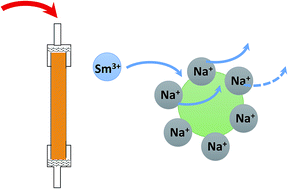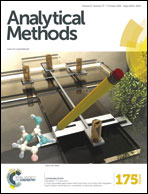Speciation of a lanthanide (Sm) using an ion exchange resin†
Abstract
Rare earth elements (REE) are economically important metals that are found in numerous high technology applications. Their release into the environment is expected to greatly increase in the near future. As for most metals, their bioavailability is expected to be strongly related to their chemical speciation. In this study, an economical and simple means, using ion exchange on a strong acid resin, was developed to evaluate the speciation of a REE (samarium) in environmental matrices. In flow experiments, resin adsorption kinetics were first determined for buffered solutions (pH = 6.0) containing Sm and for which sodium nitrate was added to control ionic strength. Those experiments showed that resin equilibration was very slow, except when using very small quantities of the resin, relatively high ionic strengths (≥0.5 M NaNO3) or high flow rates. Sm adsorption dynamics were evaluated in the presence of five ligands: NTA, EDTA, citric acid, malic acid and the Suwannee River standard fulvic acid. Both in the absence of ligand and in the presence of NTA and EDTA, a strong correlation (r2 = 0.99, slope = 0.67 L−1 g−1 min−1) was found between the rate of Sm accumulation on the resin and free samarium concentrations in solution. On the other hand, in the presence of citric and malic acid, accumulation rates were much higher than those predicted on the basis of free ion concentrations alone, suggesting that these complexes were also being measured by the resin. In the presence of the fulvic acid, the Sm accumulation rate on the resin was much higher than that predicted using thermodynamic calculations, based upon literature values of the Sm–humic acid stability constant. When accumulation rates were compared with free ion concentrations determined by fluorescence quenching titration (FQT), an excellent correlation was found (r2 = 0.98). Overall, the results suggest that the dynamic mode of the IET may be a useful tool for determinations of bioavailable Sm in natural media where humic and fulvic acids are often the main organic ligands binding the REE.


 Please wait while we load your content...
Please wait while we load your content...